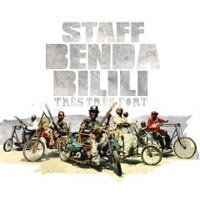
STAFF BENDA BILILI
TRES TRES FORT (Crammed CRAW51)
Here is the Cinderella story to top them all: neither Perrault nor the Grimm Brothers could have written it better. (Strabo recounts the Cinderella tale in the first century BC so it's older than I thought.) Being a cripple is bad enough: you have no dignity -- you can't go to the bathroom without someone helping you out of your wheelchair; you have to be bathed, dressed and fed. Now imagine being a cripple in the third world. It's too horrible. Congo has its share of spastics, quadriplegic polio sufferers, and people maimed in the interminable civil war, and a lot of them live on the street. In Kinshasa a bunch of them clustered together for mutual protection at the zoo. The zoo became famous during the war because the starving populace ate the animals. Now there is a resident group of cripples who play for change on home-made musical instruments. But one tourist was to change their lives: Crammed Disc's A&R Man-in-the-Bush Vincent Kenis. Kenis has kept Crammed on the straight and narrow, first with the Biblical Roots of Rumba Rock, and later with his field recordings of Kasai All Stars and Konono Numero Un. Now he has made his greatest discovery yet: Staff Benda Bilili. Their secret ingredient is a 17-year-old kid who plays a home-made one-stringed instrument, the satonge. (The paraplegics as a community protect the many thousands of thrown-away street kids in Kinshasa.) This was a hit on youtube before the album came out. Recorded live in the zoo (you can occasionally hear growling beasts in the background, screaming hyrax in "Marguerite," & even a toads' chorus), the session almost came to grief when someone stole Kenis' iPod on which he had captured some great moments, but he had already mixed the album on his laptop and only one or two solos waiting to be overdubbed were still on his lost machine. Old-school JB funk, with the sweating "Get on down" vocal exhortation can be heard on "Je T'aime" but there's R&B too, underneath the basic Congolese rumba thrust. "Sala Mosala" has a great reggae groove courtesy of Theo the bassist. A wonderful selection of tunes delivered with gusto.
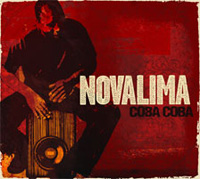
NOVALIMA
COBA COBA (Cumbancha CD9)
As in other fields, world music survival is about being versatile and adapting. In 1995 David Byrne put his imprimatur on The Soul of Black Peru, prompting the first marketing push of Susana Baca. But a decade ago Afro-Peruvian music was still a fresh concept when Network Medien put out their Musica Negra series, culminating in the two-disc set Musica Negra in the Americas. Pepe Vasquez emerged as a major exponent of this type of music, and Novalima made a promising international debut on the Mr Bongo label in 2005. Now here they are again, on the Cumbancha label, and they return with a stronger sound. It's dubbier, there's more hints of Colombian electronica. Funnily enough the traditional Peru Negra stuff like "Africa Landó" (a reworking of "Ritmo del Negros"), is almost quaint by comparison to their more edgy experiments. But then "Kumana" has a heavy insistence like Afro Funk inhabits the cajon. There's salsa dura, soca, break beats and sampling! In short a smorgasbord of Afro-Latino sounds. It's solid. There is a hint of the Sidestepper album I loved so much in 2008, and that may be the result of the British studio production of Toni Economides (who has worked with Nitin Sawnhey, among others). The band has branched away from the pop sound of their earlier album into a denser more richly layered complex soundscape with ALL Latin styles under consideration. To pull it off without sounding like a hodge-podge is a real achievement.

KOTTARASHKY
OPA HEY! (Asphalt Tango CD-ATR 2609)
Some music makes you want to jump up & shake, and then there are contemplative discs where you sit back with your soporific of choice and let the music wash over you. There are times when you are working and want music that is capable of fading into the background but helps keep you focussed on your work. This is not to dismiss this class of music as unlistenable: there are times when you don't want the music to take over, when you are concentrating on something else and music makes the routine less drab. There's a part of your brain that is comforted by a wash of sound, a bit more engaged than say the ocean. I have been playing this CD while I work and it's perfect for being present yet keeping a distance. This I attribute to the fact that it is loop-based. Kottarashky is a young mixologist with a nice grasp of vintage Balkan music. He takes archetypal Gypsy riffs: a violin whine, a skirl on the clarinet, a phrase on an accordion, and throws them into a cauldron with some trance-like drumming. It has the loping quality of Gypsy music but also the North African drone we associate with the Joujouka initiation ceremonies or Gnawa trance music. And, yes, every now and then an old geezer exclaims "Opa, hey!" He's very present for a second but then the music goes back into its rambling anecdotal tale of drab villages animated only by sheep and great floods & the guy who was half-man half-goat, conjured by fragments of half-remembered sound. It's like the end of the tram line in Sofia, where you step off into the mud and in front of you is a dark ancient land that stretches to Turkey, Arabia and India & behind you ... more darkness? You don't remember; you just know you have to keep moving away from it. This CD is an aural journey like no other. The source material is superb but it's the way Kottarashky has woven it together that makes it so unforgettable. (You can sample the music on his myspace page.)
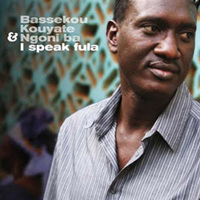
BASSEKOU KOUYATE & NGONI BA
I SPEAK FULA (Sub Pop: on iTunes now; CD releases Feb 2010)
I was thinking the great fountain of inspiration from the Sahara sands was starting to dry up, maybe with the arrival of Al Qaeda in Africa in their dunes. But my fears were groundless and here we have the latest in a glittering galaxy of musical statements that are timeless: Modern yet grounded in an antiquity that predates Noah. (Depending on who you are listening to, the great flood was not that long ago, but something has always bugged me: If the water reached to the tops of the mountains -- say 6000 feet -- where did it all go when the "waters receded"? Did God pull a plug at the bottom of the ocean?) Sub Pop is releasing this only in iTunes right now -- the physical disc will come out in February to coincide with a North American tour. Chopin said what is better than the sound of the guitar, save perhaps two guitars? In my world, multiple ngonis is the ticket. Ngoni Ba is a group of ngoni players, including Harouna Samake on kamale ngoni and Bassekou Kouyate himself on the bass instrument. Amy Sacko, the vocalist, is married to leader Bassekou. Apart from the Western pop sheen brought by Taj Mahal, Clapton and others, Kouyate has also frequently dueted with Toumani Diabaté the celebrated kora player, and he appears here again. But its the ngoni that takes centre stage. Kouyate had never seen a banjo, the modern descendant of the ngoni, until he attended a banjo pickers convention in Tennessee and was urged on stage. Now Bela Fleck is touring with the group to bring that dueling banjo intensity to the set. Kouyate has played with Toumani Diabaté in an instrumental trio, in the Symmetric Orchestra & with Ali Farka Toure. Ali's son Vieux guests here, as do griot vocalist Kasse Mady Diabaté, plus there's a stellar spike horse-hair fiddle, or soku, played by Zoumana Tereta.
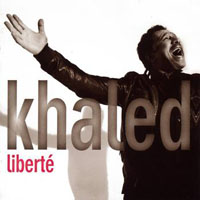
KHALED
LIBERTE (Wrasse)
I have not heard anything from Khaled since Ya-Rayi five years ago. This new release is excellent: he does some of his old hits again but they are fuller, more developed. He has given up on the cheap sound of synth and drum machine which actually suited the emergent Rai sound heard on cheap car speakers in the souk, and he has more acoustic instruments, real strings, in fact a bunch of em, with real brass, oud, & hand drums. Khaled started out wanting to be Michael Jackson (in the Jackson Five era) & got in big trouble when he father discovered he was skipping school to practice with his band. The drum machine and synth resulted from the high prices session musicians were asking so the young singer had to figure out the backing the cheapest way possible, because it was still a labour of love. After he moved from Algeria to Paris in 1989 he was able to afford musicians but the Rai sound had grown up around the drum machines and synthesized strings. Nevertheless, the reimagination of his repertoire is welcome. He has a big Cairo string orchestra to replace the tinny KORG sound, and guests Rita Marley & friends singing backup on "Raikoum," plus his regular band featuring oud player Abdelhoued Zaim, two guitarists, two keyboard players, a bunch of percussionists and trumpet, sax and trombone. The big hits, "Hiya Ansadou," "Raikoum," "Liberté," "Yamina," and "Ya Minoun," tease you with long drawn out intros before the beat drops.
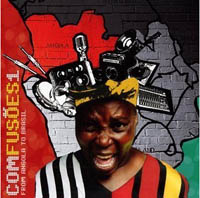
COM FUSOES 1: FROM ANGOLA TO BRAZIL
(Out Here Records B0025Y6S3M)
There's a strong connection between Angola and Brasil and now that the African colony has emerged from its endless civil war, the rich musical culture is coming back to prominence. Bonga is the brand name superstar but 30 years ago Teta Lando, Artur Nunes and Carlos Lamartine were equally big names. Like Cabo Verde, Angola had its own traditions which absorbed fado and other mournful sounds from the Portuguese motherland of the colonists. And of course those high-colonic colonists brought Angolans in chains to Brasil to work their plantations and kept doing it until very late in the 19th century. Some fared better than others. Darwin describes various Brasilian plantations and the plight of their slaves in his gripping Voyage of the Beagle. He believes the slaves are finer people than the Portuguese (good natured and athletic) and will ultimately be the rulers: "I hope the day will come when they will assert their own rights and forget to avenge their wrongs." On 14th June 1832 he went to a concert by a celebrated pianoforte player: "He said Mozart's overtures were too easy. I suppose in the same proportion as the music which he played was too hard for me to enjoy." Com Fusões however is easy to enjoy. There is a pun in the title, both confusion, and "with fusion" are signaled. DJ Dolores rips outta the speakers with her "Merengue Rebetika," an instrumental remix of Paulinho Pinheiro, that is the high point for me, even if it does have a House beat at the core. (The original is on ANGOLA 70s part of the great & sadly out-of-print Buda series of classic Angolan hits; the Avozinho track comes from volume two of ANGOLA 70s.) There's a rap which adds the contemporary bullshit factor to "Cada Cidadão Deve Sentir-se um Soldado" (which I think means every citizen should become a soldier) by Kisangela. You can listen to preview samples on Amazon. I think you'll agree the remixing enhances the originals & gives a fresh perspective on some classic tunes.
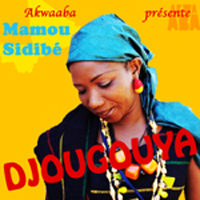
MAMOU SIDIBE
DJOUGOUYA (Akwaaba 004)
Djougouya was originally released in Mali in 2007. This album is now available as a download from Akwaaba music. I suppose with the marketing behind Oumou Sangaré it is likely to get overlooked which is a shame as she has a lovely voice and the music is modern Mali at its best. Mamou Sidibé's music has Ganadougou roots, a region close to the Wassoulou whose traditional music was indeed popularized by Oumou Sangaré. Mamou moved to Bamako, the capital, and became a backup singer for the more famous woman, but now she has followed Issa Bagayogo in adding deft techno touches, a hint of drum programming and some synthesizer, without sacrificing her traditional sound. Melodic arrangements break out into talking drum and electric guitar jams. There is organ, a full female chorus, lots of energy. "Kanakoroto" has a nice funky groove to it. "Mary" is dreamy and reminds me of Issa's mood. "Donso" is even more experimental with a busy scraper and some explosive percussion over ngoni and guitar. The last track, "Mali Mousso," has a whiny insistent guitar lead that for a moment was going to go into reggaeton! It is a great rave-up ending to this fine disc.
You can check Mamou Sidibé out on YouTube here; and here is a track from this album.
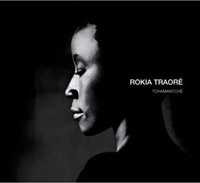
ROKIA TRAORÉ
TCHAMANTCHÉ (Nonesuch 465532-2)
I was a little apprehensive about this, after Rokia's failed collaboration with the Kronos string quartet. Someone even said she had gone pop. This is a real problem for successful artists from Francophone Africa, because their European destination is Paris or Bruxelles and they are only going to get worse once they subject themselves to the musical culture of their adopted homelands. Salif Keita and Kante Manfila are shining examples of the wretched depths African artists can plumb once they swap their homespun for designer threads. But Rokia already had class and, as her string of great albums attests, she is a gifted songwriter. She plays to her strengths on this new outing, some of the sound is reassuringly familiar, as if she knows the grooves that work, so "Tounka" sounds a lot like her early work. However she has given up the balafon and the dueling n'gonis that made her first couple of albums (& her live shows) so thrilling. There's a bluesy Ali Farka riff to the opening song "Dounia," but then some atmospheric reverb and her familiar aetherial harmonies come to the fore. "Zen" is an experiment in fusion, hosho and thumb-piano are the main instruments, and there is an unusual hesitant structure to the rhythm on guitar and keyboard. Her voice is thin but miked on top of the sound. Harp duels with ngoni on "Konandi," another outstanding example of her creative use of traditional African instruments with Western ones.
The disc falters towards the end: Rokia sings "The Man I Love" by Gershwin. There are two guitars, one in key and one looking for the key: that's a bad start, then the ngoni player is embroidering with some more distracting pluckings. Rokia sings in French-tinged English which sounds like she heard Blossom Dearie's version of the song. I suppose it's important for foreign artists to appeal to the monoglot world of English-language listeners; it shows where they would like to be considered in the tradition. If you look at the history of "The Man I Love," it was an up-tempo foxtrot in its first incarnation and it was not till Billie Holliday, probably, that it was slowed down to a dirge, but now everyone does it with regret rather than anticipation. The Duchess is more forgiving, she likes the Malian aspect and thinks Gershwin would have dug it too, after all he also went to Paris. But the last track has steel-pan effect on a synth which also seems inappropriate to Rokia's voice.
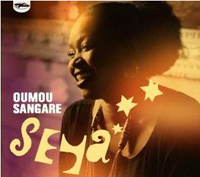
OUMOU SANGARE
SEYA (World Circuit WCD081)
It's twenty years since Oumou broke into the Western consciousness with MOUSSOLOU and six years since her last album OUMOU appeared from World Circuit. I thought her career was over because OUMOU was essentially a repackaged greatest hits. I saw her on her first US tour and thought she was fabulous. Jazz trumpeter Don Cherry was always popping into Round World Music where I worked then, to see if she had anything new (Got the latest from Omo Sangree? he would growl). But things would appear in Europe or on cassette in Mali we would hear about but never hear. I assumed she had retired or was burned out touring when World Circuit shuffled her cassettes and CDs and came up with a collection worthy to stand as her lasting monument. But I was wrong: she is back with more. Not more of the same: more Joy, which is the translation of the title. The Wassoulou sound is represented by outstanding ngoni playing from Brehima Diakité, and there's great subtlety and a band and a half of brilliant guest musicians, including Prince. (No, it can't be him. He plays electric guitar, not talking drum.) The key invitee is producer Cheick Tidiane Seck who plays Hammond organ on two tracks and arranged half of it. There's also the horn duo of Fred Wesley, trombone, and Pee Wee Ellis, sax (who, with Maceo Parker were the JB Horns, creators of da Funk). But wait! If you act now, You will also get Djelimady Tounkara on guitar on three tracks, Neba Solo on balafon on three others, Tony Allen on one track. Everybody's here, the Mamadous and the Papapdous, and then some: probably even some others you have heard of if you memorize liner notes. Great percussion, great variety, great sound mix. This is solid. There ain't a slack track on the front or the back. A must hear.
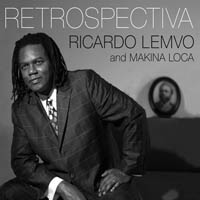
RICARDO LEMVO & MAKINA LOCA
RETROSPECTIVA (City Hall Records)
From cooking a meal to relationships, most of us feel we could do better if we tried again. Musicians get to play their hits over and over. This can be good or bad. You can be stuck in a rut (a friend of mine's brother is in It's a Beautiful Day & they still play "White Bird" at every gig -- that sounds like purgatory to me) or you can continue to evolve. Makina Loca has the kind of creativity that allows for fluidity in performance. So now after six albums they have a retrospective album that is quite new and dazzling. The track list is familiar, from "Mambo Yoyo" to "Habari Yako," in fact it's a set that you have seen them perform live over the nearly two decades they've been touring. However they have reimagined their songs to give them a new twist. It's still Afro-Cuban with the emphasis on Afro, so that "Mambo yo yo" takes the dancefloor as a son montuno but has the mutuashi rhythm associated with Tshala Muana at its heart. "Yiri Yiri Bon," their Beny Moré cover, now has a cumbia beat and accordion lead. And with the global interest in African Lusophone music, Lemvo has gone to his Angolan roots and delivers three Portuguese classics from Africa. The Angolan tracks are taken at a slower pace (The original of Carlos Lamartine's "N'Vunda ku Muceque" can be found on ANGOLA 90s for comparison.) They've moved West across the Atlantic, so there's a Haitian feel to them, or at least a touch of zouk or kompas, more aurally evident than any sign of semba. The pan-African feel is still strong, the Latin beat is heavy and once again, Ricardo Lemvo & Makina Loca keep it new and vital.